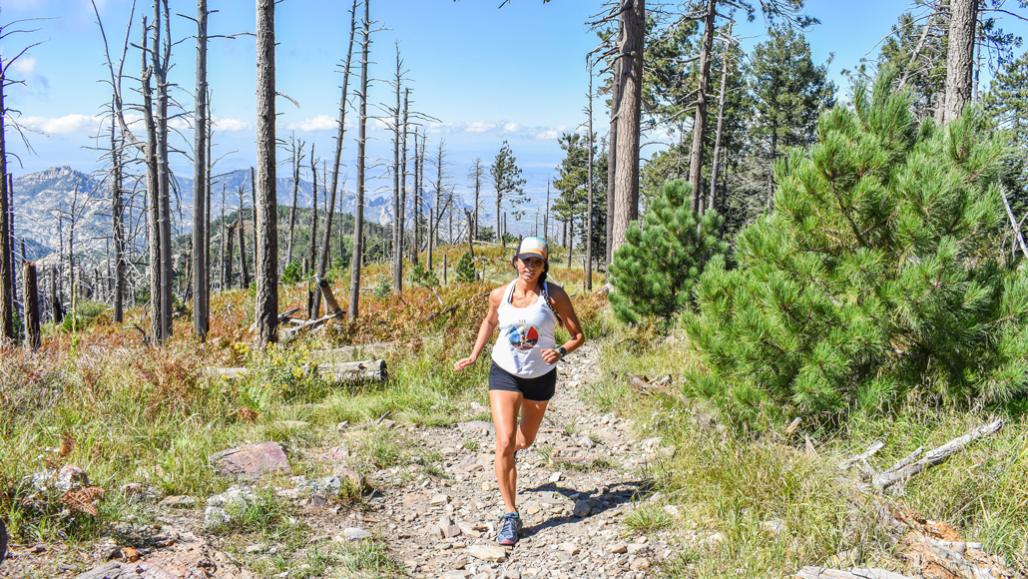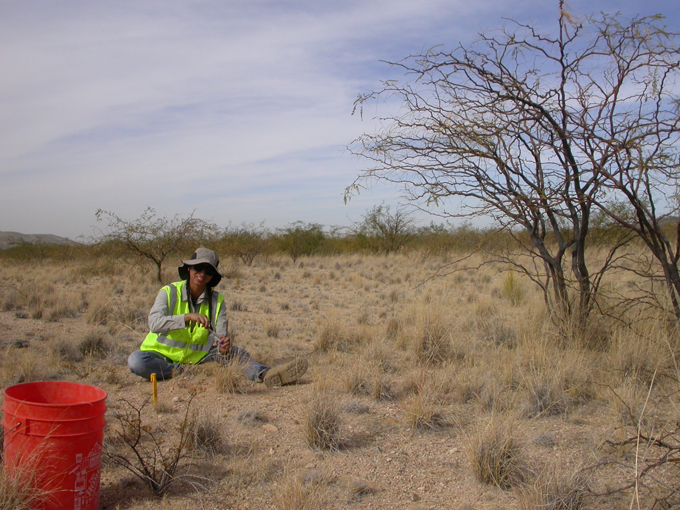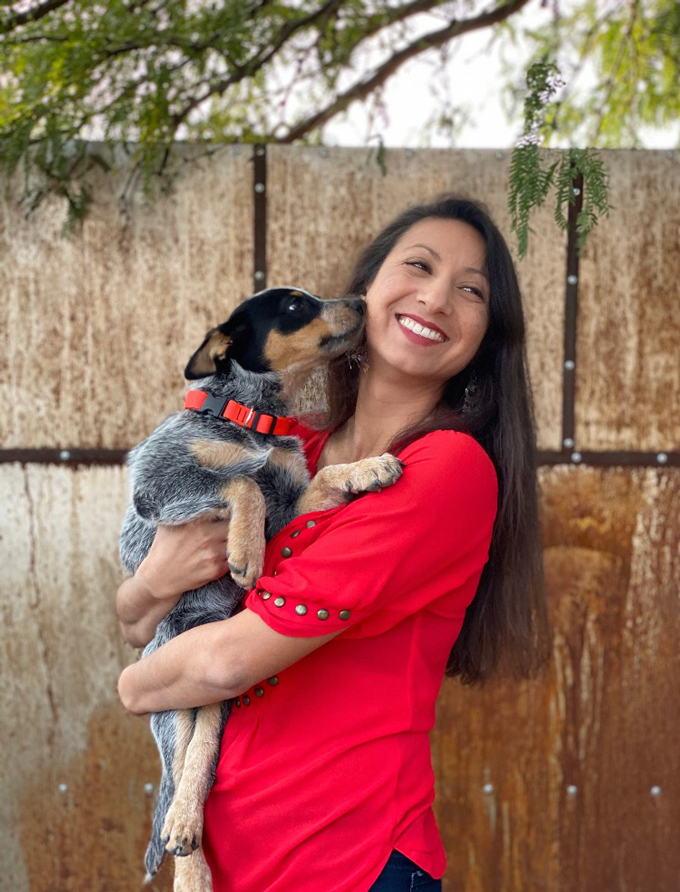Desert trails and microbial life excite this soil scientist
Lydia Jennings has taken a meandering path to studying environmental issues close to home

Running, in part, inspired Lydia Jennings’ journey as a soil scientist. Now, speeding along trails helps her relax and take time to think.
Ashleigh Thompson
Lydia Jennings has had many interests throughout her life. As a child, she trained as a dancer. But her brother insisted she’d be speedy if she ran like her siblings. So in high school, she traded her ballet slippers for running shoes. Running soon became a huge part of her life. Then an injury prompted an identity crisis. Jennings was forced to think about who she was outside of running. A growing interest in science helped answer those questions.
At the time, Jennings didn’t think about becoming a scientist. She didn’t learn about careers in research until college. No one in her family did science as people usually think of it. But Jennings — a member of two indigenous tribes (the Pascua Yaqui Tribe and the Huichol of Mexico) — now realizes that many in her family had scientific knowledge. They picked it up though gardening, their Indigenous culture and the healing practices handed down through the generations.
Jennings realized that she could do research that would benefit her community. That led her to soil science. She now studies how bacteria and plants bounce back after their soil environment has been disturbed by mining. In this interview, Jennings shares her experiences and advice with Science News for Students. (This interview has been edited for content and readability.)

Educators and Parents, Sign Up for The Cheat Sheet
Weekly updates to help you use Science News Explores in the learning environment
Thank you for signing up!
There was a problem signing you up.
What inspired you to pursue your career?
Well, I’ve always loved being outside. So that’s a really big part — just being outside and getting to know the earth around me. Running has also inspired me. I love to run. In high school in New Mexico, I was starting to see all these patterns outside. I noticed where plants grew, and how the soil in the shadowy areas of the mountain differs from soil in the more sun-exposed areas. In science classes, I then learned the language to describe what I saw out there running.
In graduate school, I would be on the trails and I’d get to experience with my feet what I was studying. Once I was running in the Sonoran Desert in Arizona after a huge rain event. The normally dry soil was saturated with water. I noticed that there was water on the soil surface. That’s rare because we have such sandy soil. And I thought about the soil properties and equations to calculate how much water the soil can hold. I also thought about the pressure that my foot applies to the soil, which was making the water come to the surface.

My classmates during college at California State University in Monterey Bay played a big part in my career, too. I got to really know them. My biology classes would go on camping trips. Everyone was as excited about science as I was. I loved that. It was such a great place to be nerdy. In some of my high school classes, it wasn’t cool to be nerdy. But in my first year of college, it was just so fun to be outside together pointing out plants, bugs and animals to each other.
How did you get where you are today?
It’s kind of been a meandering path. I took science classes in high school. But the idea of a job doing research wasn’t something I knew about. I got into research because of a professor that I had at Cabrillo College, a community college in Santa Cruz, Calif. He pointed out that I was good at science and noticed how excited I’d get about it. So I did a research internship with him and he was an important mentor for me. I remember how proud he was when he learned I was accepted into graduate school.
After that, I studied environmental science, technology and policy at California State University. It’s was such a stunning environment. You have both the redwood forest, with trees older than any human alive, and the incredible ocean. Living there, I thought I wanted to be a marine biologist. But I considered that I’m from the desert and marine biology wouldn’t help me serve my home community.
So I took a couple of years off and worked at a field station in Big Sur in California. I studied water pollution. During that time, I was able to think about how I could use my science skillsets to serve the places I’m from. I thought about their environmental issues, including those caused by mining. So many indigenous communities and places in the Southwest are impacted by mining. Mining can disturb soil ecosystems that take thousands of years to form. And digging things up can create air pollution.
Right now, I’m in the process of talking with tribal leadership about what environmental programs we might want to look into. We’re thinking about environmental health or education programs for our community. So, finally, my intellectual and cultural and moral interests have found a place to come together.
How do you get your best ideas?
A lot of times, it happens when I’m out on a run. I’m a trail runner. Trail running is when, instead of running on roads and pavement, you’re running on dirt trails or mountain trails. Trail running sometimes is a mix of hiking and running. That’s when I feel most at peace. I’m able to do some thinking then, too.
Once I was on a run and was thinking about what wasn’t working in my experiments. I came to this realization that, oh, it’s because I’m not using these specific pipette tips. It’s a small thing. But when you’re working with tiny amounts of DNA, that makes a world of difference.
Also, having conversations with friends and family members who can help me see my blind spots is really helpful.
What’s one of your biggest successes?
Winning certain awards is really valuable. So it was really nice getting the National Science Foundation’s Graduate Research Fellowship (a prestigious award for graduate students), and being selected for the American Geophysical Society Voices for Science (a program that trains scientists to be better communicators).
It’s also really valuable to have the people in my life recognize that I’m not only a scientist, but I’m also a good friend and community member. Those are really important successes to me as well. That’s because being in science can be hard. You’re constantly doing a balancing act. You want to get work done and be productive but also build friendships, take time to relax and enjoy life.
What’s one of your biggest failures, and how did you get past that?
One of the biggest failures was when some experiments were not working like I’d hoped. I was quantifying the amount of DNA from microbes in soil samples. I’d done this for bacteria. I was now going to use a new method for fungi. At that point, no one in my research group or even in the recent past had worked on fungi. So I had to go through old lab notes to figure out the protocol.
I spent six months on it, and I was getting results that I couldn’t reproduce. My advisor and I had to have a really tough discussion about whether it was worth working on this for six more months. We decided to replace it with different experiments.
That was really hard for me because I felt like I was failing. But the other method I used provided really compelling results. It told a different story. In hindsight, I don’t feel like this was a failure, but I had to get creative to find an alternative.
I think that when you have failures, they provide some of the biggest lessons. Now I feel like I know that protocol inside and out.

What do you do in your spare time?
I like to trail run and just be outside. I also like to camp and rock climb. Any of those fun outdoor activities — that’s what really makes me happy. I also like to cook. And I like to play with my puppy Salchicha. She’s a blue heeler. That’s a little cattle dog. She’ll be a good runner when she gets older.
What piece of advice do you wish you had been given when you were younger?
I wish I had been told that it’s OK to try a variety of things to find out what you’re really passionate about. I think, especially in science, that we have this tendency to think that you have to do very specific steps to be successful. But it’s really important that students experience many different things. You might never know what you’re in love with or really passionate about unless you try it.
When I was an undergrad, I was working two, sometimes three, jobs. I didn’t have time to think about what makes me happy or about my long-term goals. After college, there was so much pressure to go right to grad school. But I didn’t. I took a couple years off to really think about what I wanted to do. I did field work and laboratory work. And I developed a range of skillsets. I’m really thankful for that whole experience. Because it helped develop me as professional.
This Q&A is part of a series exploring the many paths to a career in science, technology, engineering and mathematics (STEM). It has been made possible with generous support from Arconic Foundation.







